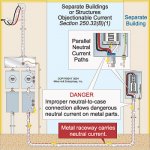NeoAmish
Member
- Location
- United States
Does a residence, with its own panel and main breaker, being fed by a meter-on-pole with its own disco, fall under 250.32(B)?
If there were no OCPD or other disco on the pole, would this then be SE instead of a feeder?
I may have been one of those kids that kept asking "why?"
It is required, but why?
My mind understands things like an EGC only being bonded at the main, not at subs, so that the EGC never shares current with the neutral, etc.
However, given two panels (one on a pole and one at the residence), if both of them are bonded to neutral, what does an extra ground wire between them do?
This may have veered from the NEC to grounding and bonding. If you would rather I posted the question in that sub-forum, I will.
The EGC and the neutral are not bonded together at the sub panels. The neutral is isolated from the non-current carrying metal parts that the EGC is bonded to.
But you would never run three wires from the meter pedestal to the house and not bond the neutral at the house. You would either run three wires and bond at the house or run four wires and bond at the meter. In the latter you do very little by running the fourth wire.As a 3 wire SE coming from a pole or ped, there is still the possibility for an open neutral to create a hazardous situation (if the neutral is bonded to the customer's panel). If the panel isn't bonded, then you run the risk of not being able to clear a GF just through the GEC alone.
it sounds like the poco's should be required to run an EGC all the time, every time.
But you would never run three wires from the meter pedestal to the house and not bond the neutral at the house. You would either run three wires and bond at the house or run four wires and bond at the meter. In the latter you do very little by running the fourth wire.
I may have been one of those kids that kept asking "why?"
It is required, but why?
...
However, given two panels (one on a pole and one at the residence), if both of them are bonded to neutral, what does an extra ground wire between them do?
 nice illustrations of on line somewhere.
nice illustrations of on line somewhere.
